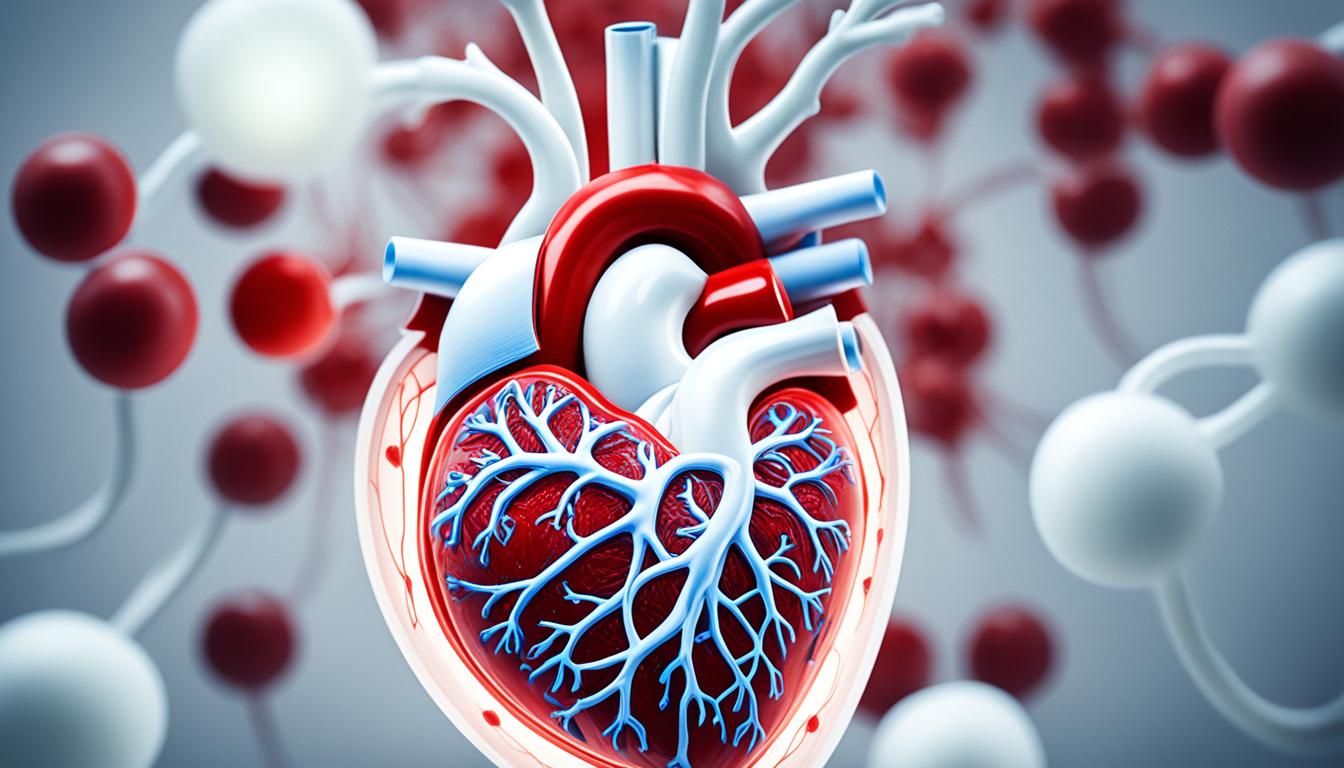Myocarditis is a heart muscle inflammation caused by viral infections or immune responses. It’s rare but can be deadly, especially for those who’ve received an allogeneic stem cell transplant. Symptoms may include fever, joint pain, and heart palpitations. Patients might also feel tired, have low blood pressure, and experience chest pain or shortness of breath.
Doctors diagnose myocarditis through tests like echo, EKG, and MRI. They might also need blood tests and a biopsy. Severe cases can cause heart failure or dangerous heart rhythms. Treatment involves managing symptoms, addressing the underlying cause, and perhaps stem cell therapy for heart repair.
Key Takeaways:
- Myocarditis is an inflammatory disease of the heart muscle caused by viral infections or immune-mediated responses.
- Symptoms of myocarditis include fever, fatigue, chest pain, and shortness of breath.
- Diagnosis involves various tests such as echocardiography, electrocardiogram, and myocardial biopsy.
- Complications of myocarditis can include heart failure, embolism, and arrhythmias.
- Treatment options include symptomatic management, addressing underlying causes, and stem cell therapy for regeneration.
Causes of Myocarditis
Myocarditis is a heart problem with many causes. Viruses, bacteria, and fungi can trigger it. So can immune responses and certain drugs or chemicals.
Viral Infections
Viral infections are often behind myocarditis. Coxsackievirus and adenovirus, among others, can cause it. These viruses are spread through various body fluids of sick people.
Bacterial, Spirochetal, and Fungal Infections
Besides viruses, bacteria, spirochetes, and fungi can also lead to myocarditis. Bacteria like diphtheria and specific spirochetes can infect the heart. Although rare, fungal infections are also a concern.
Radiation, Drugs, and Chemicals
Myocarditis can also be caused by radiation, some drugs, and chemicals. Treatments like radiation for cancer can be a risk. So can exposure to harmful substances.
Unknown Causes
Sometimes, we can’t pinpoint the exact cause of myocarditis. There might be more pathogens or immune reactions we don’t know about yet. Ongoing research aims to find more causes.
Knowing the causes is key to treating myocarditis. It helps doctors make treatment plans tailored to each patient. This can lead to better results.
Referencing a comprehensive table, we can further explore the causes of myocarditis and their associated factors:
| Type of Cause | Examples | Associated Factors |
|---|---|---|
| Viral Infections | Enteroviruses, respiratory viruses | Nasal secretions, heart tissue, throat, feces |
| Bacterial Infections | Diphtheria | N/A |
| Spirochetal Infections | N/A | N/A |
| Fungal Infections | N/A | N/A |
| Radiation Exposure | Medical radiation therapy | N/A |
| Drugs | N/A | N/A |
| Chemicals | N/A | N/A |
| Unknown Causes | N/A | N/A |
By looking at the many causes of myocarditis, doctors can focus on the best treatments. Treating the cause directly might help patients recover better.
Diagnosis and Treatment of Myocarditis
Diagnosing myocarditis needs several tests. These include imaging, lab tests, and biopsies. They check the heart’s status and find signs of inflammation.
Echocardiography looks at the heart’s shape and how it works. It finds issues like chamber size changes. Electrocardiography tracks the heart’s electricity, spotting heart rhythm problems.
Chest X-rays show the heart’s size and spot fluid buildup. This can happen in heart failure with myocarditis.
Cardiac MRI helps by showing the heart in detail. It finds inflamed or damaged areas. This gives a clear picture of the illness.
Doctors do coronary angiography to ensure there are no blood blockages like those in a heart attack. These blockages can seem like myocarditis symptoms.
Sometimes, doctors must do a myocardial biopsy. This is getting a tiny piece of heart tissue to check under a microscope. It confirms inflammation and any cause, like a virus.
The treatment depends on how bad the case is and its cause. Doctors manage heart failure with rest and meds. Some people may need devices like ECMO to help the heart work.
If a virus causes it, antiviral drugs can help. Bacterial causes may need antibiotics. But remember, antibiotics don’t treat viruses.
For severe cases, heart machines might be needed. These can help the heart heal. Stem cell therapy is also being explored for its potential.
| Diagnosis Methods | Advantages | Disadvantages |
|---|---|---|
| Echocardiography | – Non-invasive – Provides real-time images – Assesses heart function |
– Limited view of certain heart structures – Operator-dependent |
| Electrocardiography | – Non-invasive – Rapidly assesses heart’s electrical activity |
– Limited in detecting structural abnormalities |
| Chest X-ray | – Widely available – Evaluates heart and lung abnormalities |
– Limited in detecting early-stage myocarditis – Radiation exposure |
| Cardiac MRI | – Provides detailed images of heart – Assesses myocardial inflammation |
– Expensive – Contraindicated in certain individuals (e.g., those with metal implants) |
| Coronary Angiography | – Identifies blockages or narrowings in coronary arteries | – Invasive procedure – Risk of complications |
| Myocardial Biopsy | – Confirms diagnosis of myocarditis – Assesses extent of inflammation |
– Invasive procedure – Small risk of complications |
Conclusion
Myocarditis is a serious disease that can hurt the heart muscle. It can happen because of many things like viruses, some immune responses, and certain bacteria. Doctors use many tests to find out if someone has myocarditis so they can treat it right.
If you have myocarditis, doctors might tell you to rest and eat less salt. They could also give you medicines to help. In really bad cases, a person might need a machine to help their heart or even a new heart. But good news is that some treatments, like using stem cells, are showing promise in helping the heart heal.
It’s important to spot and treat myocarditis early. This helps to avoid serious heart problems. Sharing information about the disease and its treatments can help save lives. Doctors are always learning more about how to deal with myocarditis, so there’s always hope for better treatments in the future.

